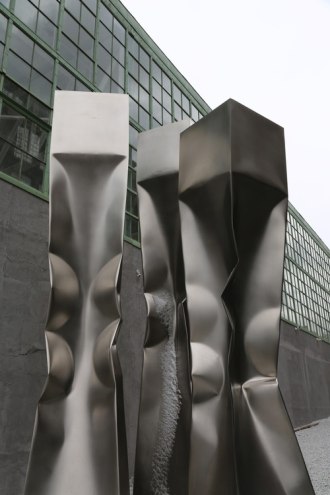
Ewerdt Hilgemann uses a vacuum pump to contort geometric volumes of welded steel, resulting in big, beautiful objects that reflect the German artist’s deconstructive approach to sculpture.
In the early 1980s, Ewerdt Hilgemann spent six weeks polishing a five-foot-tall cube of marble to perfection. Then he rolled it down a rocky mountainside. The experiment, and its mangled result, marked a new phase in Hilgemann’s creative practice: instead of using mathematical equations to shape his sculptures, he turned to unpredictable natural phenomenons like gravity and explosions. Soon the artist started vacuuming the air out of the center of hollow, welded-steel geometric forms using water or pumps, a technique used to create his so-called implosion sculptures.
Six of them comprise Panta Rhei, a phrase taken from Greek philosopher Heraclitus that means “everything flows,” and are installed outside the Mana Glass Gallery and the building’s lobby. Each large, polished object flaunts delicate folds that contrast with the toughness of the steel, addressing both sides of a single extreme. The force of the vacuum creates deflated, mangled forms with smooth surfaces and fascinating angles. In the vein of avant-garde artists like John Cage, Hilgemann utilizes the concept of chance in a minimal, thoughtful manner of making.
The Amsterdam-based artist refers to himself as an “airsmith,” a term that recognizes the substance as each piece’s co-creator. Influences of Germany’s ZERO movement are readily apparent, as Hilgemann studied under its co-founder Oskar Holweck in college. The once-perfect structures on view reflect both the industrial landscape of Hilgemann’s youth and America’s current post-industrial state: a polished facade sharply collapsing from the inside. Panta Rhei highlights the powerful potential of an invisible force, which transformed flawless shapes into almost unrecognizable forms.